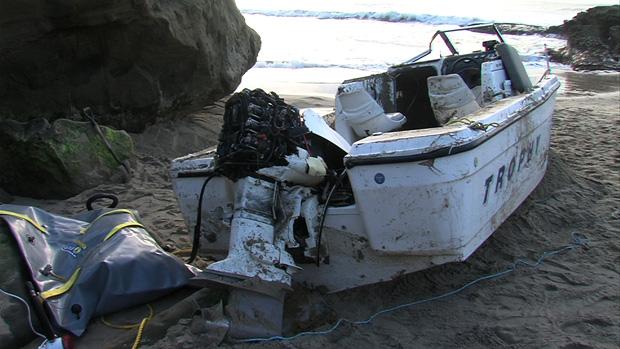Struggling to Counter Maritime Immigrant Smuggling
Smugglers of drugs and illegal immigrants are increasingly using U.S. pleasure craft for their illicit activities. They often abandon the boats along the coast. (Photo by Katie Euphrat.)
The sun is dipping below the horizon off San Diego's Ocean Beach. A tow truck is backed up to a steep cliff that falls 40 feet down to a tiny cove. It is trying to pull a small fishing boat from the sand, the kind of boat you might see out trolling for yellowtail. The boat is very stuck. Captain Eric Lamb and his boat rescue team have been working at it for 12 hours–and they're not even close.
Lamb works for a company called Vessel Assist. It's like Triple-A for boats. US Customs and Border Protection contracts out companies like it to pick up abandoned boats along California's coast. Often, smugglers, carrying illegal immigrants or drugs, abandon the boats.
Law enforcement agents–and people who work with them, like Lamb–have seen a spike in illegal traffic here. A record was set in 2012, with more than 200 documented smuggling attempts between the US-Mexico border and California's Central Coast.
Lamb has dug out, towed, and trailered many of the boats left behind.
"In the last nine years with this company we've pulled probably well over 150 boats off the beach up and down between here and LA," Lamb said.
And he is not just pulling boats off the beach. Ironically enough, some smugglers actually call Lamb's company for a tow, when they've broken down or run out of gas at sea. And he says he can tell when a client is in the smuggling business, such as when he gets a call from a boat at three in the morning and the crew is five miles off of Imperial Beach, just north of the US-Mexico border. When that happens, Lamb alerts the authorities.
Lamb is also seeing smugglers get more sophisticated. Open-hulled boats called pangas used to be the vessel of choice. Smugglers would typically take off from Mexico's border state of Baja California, race up the coast at night, and drop off their cargo, drugs or people, on deserted beaches.
At a boat yard near the Mexican border, a worker slices through the fiberglass hull of a captured smuggling boat. The word "Ensenada," the port city in Baja California, is printed on it in hand-drawn letters. A kid's life jacket and a Fanta bottle filled with water suggest it was used to smuggle immigrants. Soon, workers here will shred the boat and dismantle the motor.
Not too long ago, these abandoned or seized pangas were auctioned off. But the same boats showed up again and again. So now authorities just chop them up.
"They've managed to just about deplete the fleet in Ensenada," Lamb said.
But smugglers have retooled their strategy, too, and are now using other boats, including craft normally used for pleasure or yachting, to run their illicit business. And they're getting bolder, going farther out to sea and further up the coast, dropping their goods or people hundreds of miles up California's coast.
For law enforcement, it's getting more dangerous. In December, off Santa Barbara's coast, suspected smugglers rammed a US Coast Guard boat and killed Senior Chief Petty Officer Terrell Horne III. The smugglers fled, but were captured off San Diego. Their trial is set for February.
Lt. Commander Matthew Jones oversees the Coast Guard's enforcement in San Diego. His crew patrols the coast daily with helicopters and boats, searching for suspicious activity. Jones says Horne's death hasn't altered how the Coast Guard operates.
"I don't think it's any more dangerous than it was before," Jones said. "Horne's death was a tragedy, an absolute tragedy, and it certainly makes us all re-examine what we're doing to make sure we're doing it safely and effectively."
But that's not so for Eric Lamb, who works with Vessel Assist. As maritime smuggling increases, he finds his business increasingly nerve-wracking, especially when he approaches boats stranded at sea.
"I'll be out there, no one else, just me," he said. He know that they can "shoot me, throw me over the side, load everything in my boat and they can go anywhere they want."
Still, Lamb says he loves his job, will stick to it–he's just moving his radar higher.
